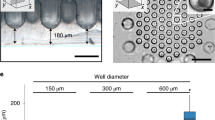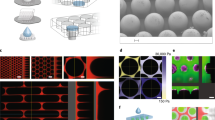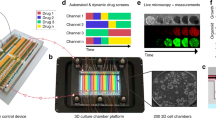Abstract
Organoid culture systems are self-renewing, three-dimensional (3D) models derived from pluripotent stem cells, adult derived stem cells or cancer cells that recapitulate key molecular and structural characteristics of their tissue of origin. They generally form into hollow structures with apical–basolateral polarization. Mass spectrometry imaging (MSI) is a powerful analytical method for detecting a wide variety of molecules in a single experiment while retaining their spatiotemporal distribution. Here we describe a protocol for preparing organoids for MSI that (1) preserves the 3D morphological structure of hollow organoids, (2) retains the spatiotemporal distribution of a vast array of molecules (3) and enables accurate molecular identification based on tandem mass spectrometry. The protocol specifically focuses on the collection and embedding of the organoids in gelatin, and gives recommendations for MSI-specific sample preparation, data acquisition and molecular identification by tandem mass spectrometry. This method is applicable to a wide range of organoids from different origins, and takes 1 d from organoid collection to MSI data acquisition.
This is a preview of subscription content, access via your institution
Access options
Access Nature and 54 other Nature Portfolio journals
Get Nature+, our best-value online-access subscription
$29.99 / 30 days
cancel any time
Subscribe to this journal
Receive 12 print issues and online access
$259.00 per year
only $21.58 per issue
Buy this article
- Purchase on Springer Link
- Instant access to full article PDF
Prices may be subject to local taxes which are calculated during checkout










Similar content being viewed by others
Data availability
The example data are available from the corresponding author upon reasonable request.
References
Sato, T. et al. Single Lgr5 stem cells build crypt-villus structures in vitro without a mesenchymal niche. Nature 459, 262–265 (2009).
van de Wetering, M. et al. Prospective derivation of a living organoid biobank of colorectal cancer patients. Cell 161, 933–945 (2015).
Boj, S. F. et al. Organoid models of human and mouse ductal pancreatic cancer. Cell 160, 324–338 (2015).
Vaes, R. D. W. et al. Generation and initial characterization of novel tumour organoid models to study human pancreatic cancer-induced cachexia. J. Cachexia Sarcopenia Muscle 11, 1509–1524 (2020).
Sachs, N. et al. Long-term expanding human airway organoids for disease modeling. EMBO J. 38, e100300 (2019).
Schutgens, F. & Clevers, H. Human organoids: tools for understanding biology and treating diseases. Annu. Rev. Pathol. 15, 211–234 (2020).
Simian, M. & Bissell, M. J. Organoids: a historical perspective of thinking in three dimensions. J. Cell Biol. 216, 31–40 (2017).
Clevers, H. Modeling development and disease with organoids. Cell 165, 1586–1597 (2016).
Romero-Calvo, I. et al. Human organoids share structural and genetic features with primary pancreatic adenocarcinoma tumors. Mol. Cancer Res. 17, 70–83 (2019).
Ščupáková, K., Dewez, F., Walch, A. K., Heeren, R. M. A. & Balluff, B. Morphometric cell classification for single-cell MALDI-mass spectrometry imaging. Angew. Chem. Int. Ed. Engl. 59, 17447–17450 (2020).
Aberle, M. R. et al. Patient-derived organoid models help define personalized management of gastrointestinal cancer. Br. J. Surg. 105, e48–e60 (2018).
Rocha, B. et al. Characterization of lipidic markers of chondrogenic differentiation using mass spectrometry imaging. Proteomics 15, 702–713 (2015).
Georgi, N. et al. Differentiation of mesenchymal stem cells under hypoxia and normoxia: lipid profiles revealed by time-of-flight secondary ion mass spectrometry and multivariate analysis. Anal. Chem. 87, 3981–3988 (2015).
Bakker, B. et al. Oxygen-dependent lipid profiles of three-dimensional cultured human chondrocytes revealed by MALDI-MSI. Anal. Chem. 89, 9438–9444 (2017).
Li, H. & Hummon, A. B. Imaging mass spectrometry of three-dimensional cell culture systems. Anal. Chem. 83, 8794–8801 (2011).
Ahlf Wheatcraft, D. R., Liu, X. & Hummon, A. B. Sample preparation strategies for mass spectrometry imaging of 3D cell culture models. J. Vis. Exp. https://doi.org/10.3791/52313 (2014).
Johnson, J., Sharick, J. T., Skala, M. C. & Li, L. Sample preparation strategies for high-throughput mass spectrometry imaging of primary tumor organoids. J. Mass Spectrom. https://doi.org/10.1002/jms.4452 (2019).
Ellis, S. R. et al. Automated, parallel mass spectrometry imaging and structural identification of lipids. Nat. Methods 15, 515–518 (2018).
Chughtai, K. & Heeren, R. M. Mass spectrometric imaging for biomedical tissue analysis. Chem. Rev. 110, 3237–3277 (2010).
Liu, X. & Hummon, A. B. Mass spectrometry imaging of therapeutics from animal models to three-dimensional cell cultures. Anal. Chem. 87, 9508–9519 (2015).
Porta Siegel, T. et al. Mass spectrometry imaging and integration with other imaging modalities for greater molecular understanding of biological tissues. Mol. Imaging Biol. 20, 888–901 (2018).
Zavalin, A., Yang, J. & Caprioli, R. Laser beam filtration for high spatial resolution MALDI imaging mass spectrometry. J. Am. Soc. Mass Spectrom. 24, 1153–1156 (2013).
Powers, T. W. et al. Matrix assisted laser desorption ionization imaging mass spectrometry workflow for spatial profiling analysis of N-linked glycan expression in tissues. Anal. Chem. 85, 9799–9806 (2013).
Judd, A. M. et al. A recommended and verified procedure for in situ tryptic digestion of formalin-fixed paraffin-embedded tissues for analysis by matrix-assisted laser desorption/ionization imaging mass spectrometry. J. Mass Spectrom. 54, 716–727 (2019).
Zubarev, R. & Mann, M. On the proper use of mass accuracy in proteomics. Mol. Cell Proteom. 6, 377–381 (2007).
Zubarev, R. A. & Makarov, A. Orbitrap mass spectrometry. Anal. Chem. 85, 5288–5296 (2013).
Barner-Kowollik, C., Gruendling, T., Falkenhagen, J. & Weidner, S. Mass Spectrometry in Polymer Chemistry 5–32 (Wiley-VCH, 2012).
Palzer, J. et al. Magnetic fluid hyperthermia as treatment option for pancreatic cancer cells and pancreatic cancer organoids. Int. J. Nanomed. 16, 2965–2981 (2021).
Broutier, L. et al. Culture and establishment of self-renewing human and mouse adult liver and pancreas 3D organoids and their genetic manipulation. Nat. Protoc. 11, 1724–1743 (2016).
Hansen, R. L. & Lee, Y. J. Overlapping MALDI-mass spectrometry imaging for in-parallel MS and MS/MS data acquisition without sacrificing spatial resolution. J. Am. Soc. Mass Spectrom. 28, 1910–1918 (2017).
OuYang, C., Chen, B. & Li, L. High throughput in situ DDA analysis of neuropeptides by coupling novel multiplex mass spectrometric imaging (MSI) with gas-phase fractionation. J. Am. Soc. Mass Spectrom. 26, 1992–2001 (2015).
Bokhart, M. T., Nazari, M., Garrard, K. P. & Muddiman, D. C. MSiReader v1.0: evolving open-source mass spectrometry imaging software for targeted and untargeted analyses. J. Am. Soc. Mass Spectrom. 29, 8–16 (2018).
Föll, M. C. et al. Accessible and reproducible mass spectrometry imaging data analysis in Galaxy. GigaScience https://doi.org/10.1093/gigascience/giz143 (2019).
Verbeeck, N., Caprioli, R. M. & Van de Plas, R. Unsupervised machine learning for exploratory data analysis in imaging mass spectrometry. Mass Spectrom. Rev. 39, 245–291 (2020).
Acknowledgements
We thank Molecular Horizon Srl, Italy, for the development of LipostarMSI and their support in analyzing organoids with their software. This work was supported by NWO-NWA Startimpuls (grant no. 400.17.604). The authors thank the NUTRIM graduate program for the personal grants supporting R.D.W.V. and M.R.A. This work was financially supported by the Dutch province of Limburg through the LINK program.
Author information
Authors and Affiliations
Contributions
B.B.: writing, protocol development, data acquisition, data processing. R.D.W.V.: writing, organoid culture, protocol development. M.R.A.: writing, organoid culture, protocol development. T.W.: writing, protocol development, organoid culture. T.H.: supervision. S.S.R.: writing, supervision, funding, project conception. S.W.M.O.D.: supervision, funding, project conception. R.M.A.H.: supervision, funding, project conception.
Corresponding author
Ethics declarations
Competing interests
The authors declare no competing interests.
Peer review
Peer review information
Nature Protocols thanks Aleksandra Aizenshtadt, Choi-Fong Cho, Amanda Hummon, Hanne Røberg-Larsen and the other, anonymous, reviewer(s) for their contribution to the peer review of this work.
Additional information
Publisher’s note Springer Nature remains neutral with regard to jurisdictional claims in published maps and institutional affiliations.
Related links
Key references using this protocol
Ščupáková, K. et al. Angew Chem. Int. Ed. Engl. 59, 17447–17450 (2020): https://doi.org/10.1002/anie.202007315
Ellis, S. R. et al. Nat. Methods 15, 515–518 (2018): https://doi.org/10.1038/s41592-018-0010-6
Supplementary information
Supplementary Information
Supplementary Methods 1–6, Supplementary Figs. 1–4 and Supplementary Table 1.
Rights and permissions
About this article
Cite this article
Bakker, B., Vaes, R.D.W., Aberle, M.R. et al. Preparing ductal epithelial organoids for high-spatial-resolution molecular profiling using mass spectrometry imaging. Nat Protoc 17, 962–979 (2022). https://doi.org/10.1038/s41596-021-00661-8
Received:
Accepted:
Published:
Issue Date:
DOI: https://doi.org/10.1038/s41596-021-00661-8
This article is cited by
-
Identification and validation of serum metabolite biomarkers for endometrial cancer diagnosis
EMBO Molecular Medicine (2024)
-
Human disease models in drug development
Nature Reviews Bioengineering (2023)
-
Visualization of metabolites and microbes at high spatial resolution using MALDI mass spectrometry imaging and in situ fluorescence labeling
Nature Protocols (2023)
Comments
By submitting a comment you agree to abide by our Terms and Community Guidelines. If you find something abusive or that does not comply with our terms or guidelines please flag it as inappropriate.



